
The United States Department of Homeland Security (DHS) is the U.S. federal executive department responsible for public security, roughly comparable to the interior or home ministries of other countries. Its stated missions involve anti-terrorism, border security, immigration and customs, cyber security, and disaster prevention and management.

The National Cyber Security Division (NCSD) is a division of the Office of Cyber Security & Communications, within the United States Department of Homeland Security's Cybersecurity and Infrastructure Security Agency. Formed from the Critical Infrastructure Assurance Office, the National Infrastructure Protection Center, the Federal Computer Incident Response Center, and the National Communications System, NCSD opened on June 6, 2003. The NCSD mission is to collaborate with the private sector, government, military, and intelligence stakeholders to conduct risk assessments and mitigate vulnerabilities and threats to information technology assets and activities affecting the operation of the civilian government and private sector critical cyber infrastructures. NCSD also provides cyber threat and vulnerability analysis, early warning, and incident response assistance for public and private sector constituents. NCSD carries out the majority of DHS’ responsibilities under the Comprehensive National Cybersecurity Initiative. The FY 2011 budget request for NCSD is $378.744 million and includes 342 federal positions. The current director of the NCSD is John Streufert, former chief information security officer (CISO) for the United States Department of State, who assumed the position in January 2012.
An explosives trace-detection portal machine, also known as a trace portal machine and commonly known as a puffer machine, is a security device that seeks to detect explosives and illegal drugs at airports and other sensitive facilities as a part of airport security screening. The machines are intended as a secondary screening device, used as a complement to, rather than a substitute for, traditional X-ray machines.
The Memorial Institute for the Prevention of Terrorism (MIPT) was a non-profit organization founded in response to the 1995 Oklahoma City bombing. Supported by Department of Homeland Security and other government grant funds, it conducted research into the causes of terrorism and maintained the MIPT Terrorism Knowledge Base — which was an online database of terrorist incidents, groups, and other information. MIPT also worked in conjunction with RAND, for some of its research and analysis. The institute provided training and professional development dedicated to improving the skills of law enforcement officers.
Homeland Security Advanced Research Projects Agency (HSARPA) is a part of the Science and Technology Directorate at the United States Department of Homeland Security. Much like DARPA in the Department of Defense, HSARPA is tasked with advanced projects to advance the technology needed to protect the US. Some of the chief beneficiaries of HSARPA are the Customs and Border Protection, and the Office of Intelligence and Analysis.
The Homeland Security Subcommittee on Emergency Management and Technology is a subcommittee within the House Homeland Security Committee. Established in 2007 as a new subcommittee, it handles many of the duties of the former Subcommittee on Emergency Preparedness, Science, and Technology. The Subcommittee focuses on: emergency preparedness, response, mitigation, resilience, and recovery; DHS grant programs; homeland security research and development; and protecting against and mitigating Weapon of mass destruction(WMDs) and health security threats. Subcommittee maintains oversight of the Federal Emergency Management Agency (FEMA), DHS Science and Technology Directorate (S&T), the Office of Countering Weapons of Mass Destruction (CWMD) Between 2019 and 2023, it was known as the Homeland Security Subcommittee on Emergency Preparedness, Response and Recovery.

The Border and Maritime Security Division (BMD) is a division of the Science and Technology Directorate of the United States Department of Homeland Security. Within the Homeland Security Advanced Research Projects Agency, BMD develops tools and technologies that improve the security of the United States's land borders and waterways.

Project Hostile Intent is an ongoing project of the United States Department of Homeland Security and Human Factors Division. It has been renamed to Future Attribute Screening Technology. This project comes under the Social and Behavioral Research (SBR) Program, one of the three broad program areas within the Science and Technology (S&T) Directorate of the Department of Homeland Security (DHS) that "sponsors research to inform, develop, and test tools and methodologies to assess terrorist threats, understand terrorism, and improve national security".

The Chemical and Biological Defense Division (CBD) is a division of the Science and Technology Directorate of the United States Department of Homeland Security. Within the Homeland Security Advanced Research Projects Agency, CBD develops technologies to increase the United States's preparedness and protect key national infrastructure against chemical, biological, and agricultural threats and disasters through improved threat awareness and advanced surveillance, detection, and protective countermeasures.
According to the DHS S&T website, the Command, Control, and Interoperability Division was a unit of the DHS Science and Technology Directorate which "develops interoperable communication standards and protocols for emergency responders, cyber security tools for protecting the integrity of the Internet, and automated capabilities to recognize and analyze potential threats."

The Human Factors and Behavioral Sciences Division (HFD) is a division of the Science and Technology Directorate of the United States Department of Homeland Security. Within the Homeland Security Advanced Research Projects Agency, HFD applies social and behavioral sciences to improve detection, analysis, and understanding and response to homeland security threats.

The Infrastructure Protection and Disaster Management Division (IDD) is a division of the Science and Technology Directorate of the United States Department of Homeland Security. Within the Homeland Security Advanced Research Projects Agency, IDD develops technologies to improve and increase the United States' strategic preparedness response to natural and man-made threats through situational awareness, emergency response capabilities, and critical infrastructure protection.

The Domestic Nuclear Detection Office (DNDO) is a jointly staffed office established on April 15, 2005 by the United States to improve the nation’s capability to detect and report unauthorized attempts to import, possess, store, develop, or transport nuclear or radiological material for use against the nation, and to further enhance this capability over time.

The Under Secretary of Homeland Security for Science and Technology is a high level civilian official in the United States Department of Homeland Security. The Under Secretary, as head of the Science and Technology Directorate at DHS, is the principal staff assistant and adviser to both the Secretary of Homeland Security and the Deputy Secretary of Homeland Security for all DHS technological research.

The Command, Control and Interoperability Division is a bureau of the United States Department of Homeland Security's Science and Technology Directorate, run by Dr. David Boyd. This division is responsible for creating informative resources(including standards, frameworks, tools, and technologies) that strengthen communications interoperability, improve Internet security, and integrity and accelerate the development of automated capabilities to help identify potential threats to the U.S.

A Visible Intermodal Prevention and Response team, sometimes Visible Intermodal Protection and Response (VIPR) is a Transportation Security Administration program. Various government sources have differing descriptions of VIPR's exact mission. It is specifically authorized by 6 U.S.C. § 1112 which says that the program is to "augment the security of any mode of transportation at any location within the United States". Authority for the program is under the Secretary of Homeland Security. The program falls under TSA's Office of Law Enforcement/Federal Air Marshal Service. TSA OLE/FAMS shares responsibility for the program with the Office of Security Operations and Transportation Sector Network Management.
National Urban Security Technology Laboratory is a United States government-owned, government-operated laboratory, part of the Department of Homeland Security (DHS) Science & Technology Directorate. It is located in the Federal Office Building at 201 Varick Street in the Hudson Square neighborhood, Manhattan, New York.

The Cyber Security Division (CSD) is a division of the Science and Technology Directorate (S&T Directorate) of the United States Department of Homeland Security (DHS). Within the Homeland Security Advanced Research Projects Agency, CSD develops technologies to enhance the security and resilience of the United States' critical information infrastructure from acts of terrorism. S&T supports DHS component operational and critical infrastructure protections, including the finance, energy, and public utility sectors, as well as the first responder community.
The National Domestic Preparedness Consortium (NDPC) is a training partner and established training arm of the U.S. Department of Homeland Security DHS/FEMA. It is a professional alliance of seven national institutions and organizations that work to develop and deliver training, technical assistance, plan assessments, and exercises to emergency responders and first receivers at the territories, state, local and tribal levels. The members were chosen for their unique knowledge bases in the areas of chemical, biological, radiological, nuclear, explosive, medical, critical infrastructure, and incident management, and have enhanced their core competencies at the request of DHS and FEMA to include other areas as well. The following is a list of the NDPC members and their core competencies:

The Cybersecurity and Infrastructure Security Agency (CISA) is an agency of the United States Department of Homeland Security (DHS) that is responsible for strengthening cybersecurity and infrastructure protection across all levels of government, coordinating cybersecurity programs with U.S. states, and improving the government's cybersecurity protections against private and nation-state hackers. Its activities are a continuation of the National Protection and Programs Directorate (NPPD), and was established on November 16, 2018, when President Donald Trump signed into law the Cybersecurity and Infrastructure Security Agency Act of 2018.






